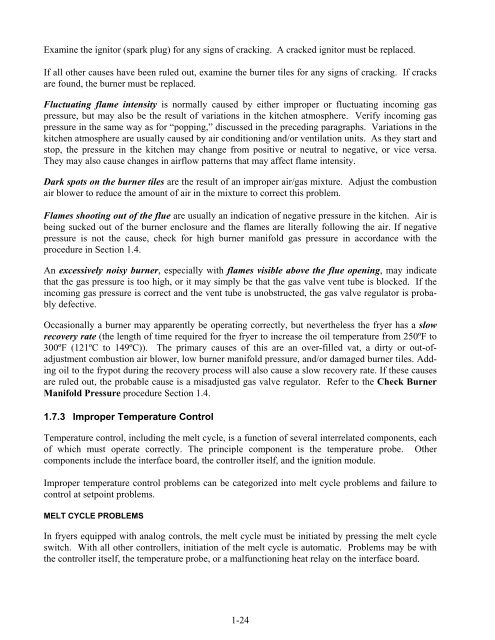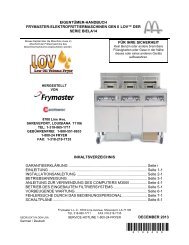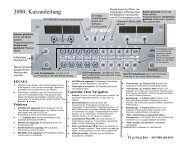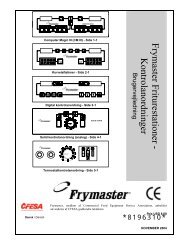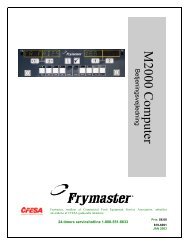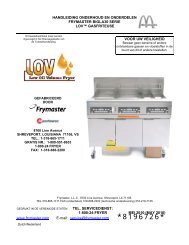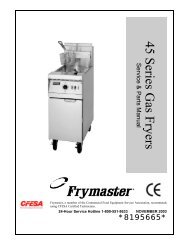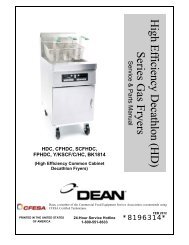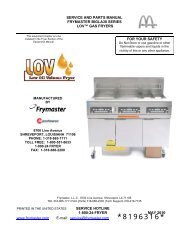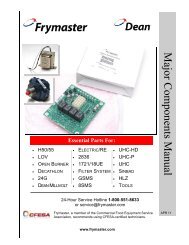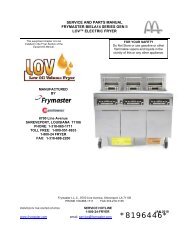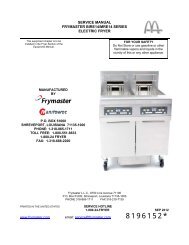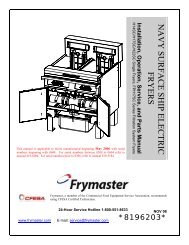819-0001 JUN 07.pdf - Frymaster
819-0001 JUN 07.pdf - Frymaster
819-0001 JUN 07.pdf - Frymaster
Create successful ePaper yourself
Turn your PDF publications into a flip-book with our unique Google optimized e-Paper software.
Examine the ignitor (spark plug) for any signs of cracking. A cracked ignitor must be replaced.<br />
If all other causes have been ruled out, examine the burner tiles for any signs of cracking. If cracks<br />
are found, the burner must be replaced.<br />
Fluctuating flame intensity is normally caused by either improper or fluctuating incoming gas<br />
pressure, but may also be the result of variations in the kitchen atmosphere. Verify incoming gas<br />
pressure in the same way as for “popping,” discussed in the preceding paragraphs. Variations in the<br />
kitchen atmosphere are usually caused by air conditioning and/or ventilation units. As they start and<br />
stop, the pressure in the kitchen may change from positive or neutral to negative, or vice versa.<br />
They may also cause changes in airflow patterns that may affect flame intensity.<br />
Dark spots on the burner tiles are the result of an improper air/gas mixture. Adjust the combustion<br />
air blower to reduce the amount of air in the mixture to correct this problem.<br />
Flames shooting out of the flue are usually an indication of negative pressure in the kitchen. Air is<br />
being sucked out of the burner enclosure and the flames are literally following the air. If negative<br />
pressure is not the cause, check for high burner manifold gas pressure in accordance with the<br />
procedure in Section 1.4.<br />
An excessively noisy burner, especially with flames visible above the flue opening, may indicate<br />
that the gas pressure is too high, or it may simply be that the gas valve vent tube is blocked. If the<br />
incoming gas pressure is correct and the vent tube is unobstructed, the gas valve regulator is probably<br />
defective.<br />
Occasionally a burner may apparently be operating correctly, but nevertheless the fryer has a slow<br />
recovery rate (the length of time required for the fryer to increase the oil temperature from 250ºF to<br />
300ºF (121ºC to 149ºC)). The primary causes of this are an over-filled vat, a dirty or out-ofadjustment<br />
combustion air blower, low burner manifold pressure, and/or damaged burner tiles. Adding<br />
oil to the frypot during the recovery process will also cause a slow recovery rate. If these causes<br />
are ruled out, the probable cause is a misadjusted gas valve regulator. Refer to the Check Burner<br />
Manifold Pressure procedure Section 1.4.<br />
1.7.3 Improper Temperature Control<br />
Temperature control, including the melt cycle, is a function of several interrelated components, each<br />
of which must operate correctly. The principle component is the temperature probe. Other<br />
components include the interface board, the controller itself, and the ignition module.<br />
Improper temperature control problems can be categorized into melt cycle problems and failure to<br />
control at setpoint problems.<br />
MELT CYCLE PROBLEMS<br />
In fryers equipped with analog controls, the melt cycle must be initiated by pressing the melt cycle<br />
switch. With all other controllers, initiation of the melt cycle is automatic. Problems may be with<br />
the controller itself, the temperature probe, or a malfunctioning heat relay on the interface board.<br />
1-24


